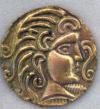Our Sun Has A Twin, ESA Reveals A Second Sun - Alpha Centauri A

The Sun’s nearest neighbors are the three stars of the Alpha Centauri system. The faint red dwarf, Proxima Centauri, is nearest at just 4.24 light-years, with the tight double star, Alpha Centauri AB, slightly further away at 4.37 light-years.
Alpha Centauri B has recently been in the news after the discovery of an Earth-mass planet in orbit around it. But Alpha Centauri A is also very important to astronomers: almost a twin to the Sun in mass, temperature, chemical composition and age, it provides an ideal natural laboratory to compare other characteristics of the two stars.
One of the great curiosities in solar science is that the Sun’s wispy outer atmosphere – the corona – is heated to millions of degrees while the visible surface of the Sun is ‘only’ about 6000ºC. Even stranger, there is a temperature minimum of about 4000ºC between the two layers, just a few hundred kilometres above the visible surface in the part of Sun’s atmosphere called the chromosphere. Now, using ESA’s Herschel space observatory, scientists have made the first discovery of an equivalent cool layer in the atmosphere of the Sun-like star, Alpha Centauri A.
Credit: ESA
Both layers can be seen during a total solar eclipse, when the Moon briefly blocks the bright face of the Sun: the chromosphere is a pink-red ring around the Sun, while the ghostly white plasma streamers of the corona extend out millions of kilometres.
The heating of the Sun’s atmosphere has been a conundrum for many years, but is likely to be related to the twisting and snapping of magnetic field lines sending energy rippling through the atmosphere and out into space – possibly in the direction of Earth – as solar storms. Why there is a temperature minimum has also long been of interest to solar scientists.
Now, by observing Alpha Centauri A in far-infrared light with Herschel and comparing the results with computer models of stellar atmospheres, scientists have made the first discovery of an equivalent cool layer in the atmosphere of another star.
“The study of these structures has been limited to the Sun until now, but we clearly see the signature of a similar temperature inversion layer at Alpha Centauri A,” says René Liseau of the Onsala Space Observatory, Sweden, and lead author of the paper presenting the results.
“Detailed observations of this kind for a variety of stars might help us decipher the origin of such layers and the overall atmospheric heating puzzle.”
Understanding the temperature structure of stellar atmospheres may also help to determine the presence of dusty planet-forming discs around other stars like the Sun.
“Although it is likely only a small effect, a temperature minimum region in other stars could result in us underestimating the amount of dust present in a cold debris disc surrounding it,” says Dr Liseau.
“But armed with a more detailed picture of how Alpha Centauri A shines, we can hope to make more accurate detections of the dust in potential planet-bearing systems around other Sun-like stars.”
“These observations are an exciting example of how Herschel can be used to learn more about processes in our own Sun, as well as in other Sun-like stars and the dusty discs that may exist around them,” says Göran Pilbratt, ESA’s Herschel Project Scientist.
“α Centauri A in the far infrared. First measurement of the temperature minimum of a star other than the Sun,” by R. Liseau et al. is published in Astronomy & Astrophysics 549, L7 (2013).
The survey was conducted as part of the DUNES (Dust around Nearby Stars) Herschel Key Programme. Data were collected by the PACS instrument at 100 μm and 160 μm for the DUNES survey, and PACS 70 μm and 160μm and SPIRE 250 μm, 350 μm and 500 μm data obtained as part of the Hi-GAL programme were also analysed. Additional space- and ground-based infrared data were also included.
Herschel is an ESA space observatory with science instruments provided by European-led Principal Investigator consortia and with important participation from NASA.
Contacts and sources:
Markus Bauer
ESA Science and Robotic Exploration Communication Officer
René Liseau
Chalmers University of Technology, Onsala Space Observatory, Sweden
Göran Pilbratt
ESA Herschel Project Scientist
Anyone can join.
Anyone can contribute.
Anyone can become informed about their world.
"United We Stand" Click Here To Create Your Personal Citizen Journalist Account Today, Be Sure To Invite Your Friends.
Before It’s News® is a community of individuals who report on what’s going on around them, from all around the world. Anyone can join. Anyone can contribute. Anyone can become informed about their world. "United We Stand" Click Here To Create Your Personal Citizen Journalist Account Today, Be Sure To Invite Your Friends.
LION'S MANE PRODUCT
Try Our Lion’s Mane WHOLE MIND Nootropic Blend 60 Capsules
Mushrooms are having a moment. One fabulous fungus in particular, lion’s mane, may help improve memory, depression and anxiety symptoms. They are also an excellent source of nutrients that show promise as a therapy for dementia, and other neurodegenerative diseases. If you’re living with anxiety or depression, you may be curious about all the therapy options out there — including the natural ones.Our Lion’s Mane WHOLE MIND Nootropic Blend has been formulated to utilize the potency of Lion’s mane but also include the benefits of four other Highly Beneficial Mushrooms. Synergistically, they work together to Build your health through improving cognitive function and immunity regardless of your age. Our Nootropic not only improves your Cognitive Function and Activates your Immune System, but it benefits growth of Essential Gut Flora, further enhancing your Vitality.
Our Formula includes: Lion’s Mane Mushrooms which Increase Brain Power through nerve growth, lessen anxiety, reduce depression, and improve concentration. Its an excellent adaptogen, promotes sleep and improves immunity. Shiitake Mushrooms which Fight cancer cells and infectious disease, boost the immune system, promotes brain function, and serves as a source of B vitamins. Maitake Mushrooms which regulate blood sugar levels of diabetics, reduce hypertension and boosts the immune system. Reishi Mushrooms which Fight inflammation, liver disease, fatigue, tumor growth and cancer. They Improve skin disorders and soothes digestive problems, stomach ulcers and leaky gut syndrome. Chaga Mushrooms which have anti-aging effects, boost immune function, improve stamina and athletic performance, even act as a natural aphrodisiac, fighting diabetes and improving liver function. Try Our Lion’s Mane WHOLE MIND Nootropic Blend 60 Capsules Today. Be 100% Satisfied or Receive a Full Money Back Guarantee. Order Yours Today by Following This Link.








I have twins in my cod sac, how bout that?
A “twin” as the term is used in the title of this article would imply some kind of orbital connection. There is none of this in the article, so no our nearest star is not a twin to Sol.
If the corona is 1 million degrees, how can one measure a cooler temperature behind it?
That is one of the big mysteries to which that article alludes. Somewhere, scientists are getting paid to argue about how this might be.
Closest is a Black Sun at 2,1 ly in Perseus that radiates in ultraviolet